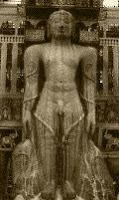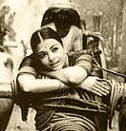 The word 'Guru' is one of India's contributions to the English language that has now become quite ubiquitous. Quite often, we come across usages like 'Management-Guru', 'Fashion-Guru' and 'Language-Guru' in the media where the word is used to denote an 'expert' or 'mentor'. The word in Sanskrit has a deeper esoteric meaning though. 'Gu' means 'darkness' and 'Ru' means 'dispel' giving the meaning "one who dispels darkness" to the term. There is a verse:
The word 'Guru' is one of India's contributions to the English language that has now become quite ubiquitous. Quite often, we come across usages like 'Management-Guru', 'Fashion-Guru' and 'Language-Guru' in the media where the word is used to denote an 'expert' or 'mentor'. The word in Sanskrit has a deeper esoteric meaning though. 'Gu' means 'darkness' and 'Ru' means 'dispel' giving the meaning "one who dispels darkness" to the term. There is a verse:"Ajnaana Thimiraandhasya
Jnaanaanjana Shalaakayaa
Chakshurunmeelitham Yena
Thasmai Sree Gurave Namah:"
Jnaanaanjana Shalaakayaa
Chakshurunmeelitham Yena
Thasmai Sree Gurave Namah:"
- I offer my salutation to that Guru, who cures the blindness of ignorance with the balm of knowledge
The 'darkness-light' metaphor itself gives a hint to the position that the 'Guru' or teacher occupied in Indian culture, since it has always been a divine duty to say "Let there be light!"
"Gurur Brahma, Gurur Vishnu
Gurur Devo Maheshwara
Gurur sakshaath Parabrahma
Thasmai Sree Gurave Namah:"
Gurur Devo Maheshwara
Gurur sakshaath Parabrahma
Thasmai Sree Gurave Namah:"
- I offer my salutation to the Guru, who is Brahma- the creator, Vishnu- the sustainer, Shiva-the destroyer and the ultimate truth.
The concept of placing the Guru along with God, if not above, and the importance given to the Teacher in society are reflections of a tradition that was knowledge-centric. India was the birthplace of knowledge in every realm conceivable - be it mathematics, science, engineering, medicine, arts, economics or applied sciences. Right from ancient times, Indians gave importance to imparting the light of knowledge to everyone possible. The Vedas and Upanishads proclaim this. Sadly, there have been rather long, dark periods in our history when this light was denied to a large multitude on the grounds of caste.
The basis of the ancient Indian educational system was the closeness or togetherness of the teacher and disciple ('Guru' and 'Sishya'). The following very popular verse from the 'Katopanishad' shows them praying together.
"Sahanavavathu Saha Nau Bhunakthu
Saha Veeryam karvavahai
Tejasvinavadhitam astu.
Ma Vidvishavahai"
Saha Veeryam karvavahai
Tejasvinavadhitam astu.
Ma Vidvishavahai"
- May we both (teacher and disciple) be protected. May we both enjoy the fruits of knowledge, meditation and devotion. May we both have strength. May what we have studied together possess brilliance. May we not hate one another.
Traditionally, teaching took place in the teacher's house itself.
 In this 'Gurukula' system, the students stayed at the teacher's house and formed a part of his family. The best thing about this system was that there was no discrimination in treatment of the students; be it a prince or a commoner, all were treated alike. They had no servants. They did everything by themselves. They even helped the teacher's wife in the household chores. The Guru imparted to them everything he knew. After the studies were completed, the disciple was bound to give anything that the guru asked for as his fee- 'Guru-Dakshina'. Without the Dakshina, it was believed, the knowledge he gained was futile.
In this 'Gurukula' system, the students stayed at the teacher's house and formed a part of his family. The best thing about this system was that there was no discrimination in treatment of the students; be it a prince or a commoner, all were treated alike. They had no servants. They did everything by themselves. They even helped the teacher's wife in the household chores. The Guru imparted to them everything he knew. After the studies were completed, the disciple was bound to give anything that the guru asked for as his fee- 'Guru-Dakshina'. Without the Dakshina, it was believed, the knowledge he gained was futile.How many stories we find in our scriptures, to depict the different shades of the 'Guru-Sishya' relation!!!
 Krishna helping Kuchela generously years after they passed out from Sandeepani's gurukula; Aruni guarding the fields of his teacher- Dhaumya, from flood water from the neighbouring fields by lying down and making himself a dam; Uthanka, the disciple of Gauthama who served him till his old age, went and collected the ornaments of a cannibal's wife and got his youth back; Ekalavya sacrificing his thumb as 'Guru Dakshina' to Drona, even though he was never trained by the latter; the poet Sukumara, who gave himself a death sentence out of remorse because he thought of killing his teacher…
Krishna helping Kuchela generously years after they passed out from Sandeepani's gurukula; Aruni guarding the fields of his teacher- Dhaumya, from flood water from the neighbouring fields by lying down and making himself a dam; Uthanka, the disciple of Gauthama who served him till his old age, went and collected the ornaments of a cannibal's wife and got his youth back; Ekalavya sacrificing his thumb as 'Guru Dakshina' to Drona, even though he was never trained by the latter; the poet Sukumara, who gave himself a death sentence out of remorse because he thought of killing his teacher…Teachers of those days were really "oceans of knowledge". The greater their knowledge, the more modesty and humility they showed. They never claimed to possess all the knowledge that a student required. It was said:
"Aacharyaad Padmaadathe
Paadam Sishya swamedhaya
Paadam Sabrahmacharibhyam
Paadam Kaalakramenathu"
Paadam Sishya swamedhaya
Paadam Sabrahmacharibhyam
Paadam Kaalakramenathu"
- Only a quarter of the knowledge is obtained from the teacher, the rest a student procures from his own analysis, from his friends and from experiences in life.
The prominence and respect given to the teacher
 in Indian culture has often led to a misconception that the teacher forced his autocratic power over the students. But the truth was far from it. Even after delivering one of the greatest lessons on crisis management – which he claims is more secret than secrecy itself- Krishna tells Arjuna: "Vimarsedath asheshena Yadhechhasi Thadha Kurum"- Fully ponder over what I said and do as you like.
in Indian culture has often led to a misconception that the teacher forced his autocratic power over the students. But the truth was far from it. Even after delivering one of the greatest lessons on crisis management – which he claims is more secret than secrecy itself- Krishna tells Arjuna: "Vimarsedath asheshena Yadhechhasi Thadha Kurum"- Fully ponder over what I said and do as you like.Buddha's final advice to his disciples echoes the same idea:
Parishya Bhikshuvo Graahyan
Madvajo Na Thu Gauravaath"
Madvajo Na Thu Gauravaath"
- Accept my teachings only after testing them; do not accept them blindly because I am your teacher
This can be considered as the highlight of education in Ancient India – It encouraged the students to think independently, test their knowledge and accept only what matched their convictions.
It is not surprising that India had well organized universities more than a millennium before Oxford and Cambridge. They were the logical extensions of the Gurukula system, but on a huge scale. Nalanda, Takshasila (Taxila), Vikramasila, Kashi and Ajanta were the prominent ones. Takshasila, established during the time of Buddha and Mahavira survived for 1200 years.

 In its hey days, it boasted a faculty which included greats like Panini, Charaka and Kautiliya. Unlike Taxila, where the disciples stayed in the teachers’ houses, Nalanda had different colleges. Hsuan–Tsang, the Chinese traveler who visited Nalanda was bowled over by its majesty. Can you imagine a university complex in the 6th century B.C, with 8 separate compounds, 10 temples, meditation halls, classrooms and a nine storied library? Nalanda accommodated over 10000 students and 2000 teachers who came from as far as Korea, Japan, China, Tibet, Indonesia, Persia and Turkey. Foreign invasions destroyed the physical existence of these universities.
In its hey days, it boasted a faculty which included greats like Panini, Charaka and Kautiliya. Unlike Taxila, where the disciples stayed in the teachers’ houses, Nalanda had different colleges. Hsuan–Tsang, the Chinese traveler who visited Nalanda was bowled over by its majesty. Can you imagine a university complex in the 6th century B.C, with 8 separate compounds, 10 temples, meditation halls, classrooms and a nine storied library? Nalanda accommodated over 10000 students and 2000 teachers who came from as far as Korea, Japan, China, Tibet, Indonesia, Persia and Turkey. Foreign invasions destroyed the physical existence of these universities.Muslim rulers in the 11th century and British in the 19th century started many schools and colleges across the country, thus laying the foundation of modern education in India. But one can find that educational reforms in India were never continuous. Each time a new system comes into existence, its does that by uprooting the former or at least making drastic changes. Even in modern times, educational policies undergo sea changes with changing governments, where often their direct impact on future generations is forgotten. It may not be possible to revive the ancient ‘Gurukula’ system and teaching methods as such. It’s not desired too. What is needed is assimilating the essence of every system and deriving a best one. As the ancient Indian thought goes: "Aano Bhadraa Kruthavo yanthu viswathaa"- Let Noble thoughts come from every side...
[Written for the Teacher's Day special of "The Wonder that is India"- a column on Indian Heritage]
[Thoolika- September 2007]








































